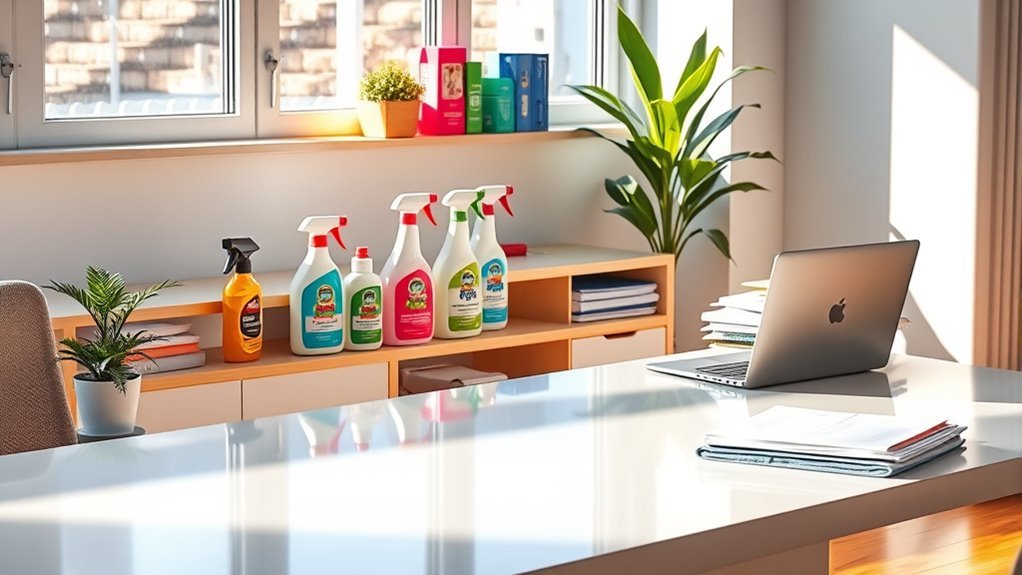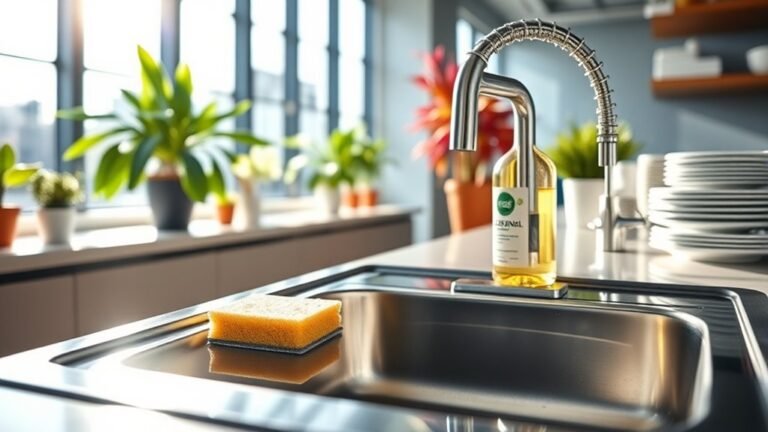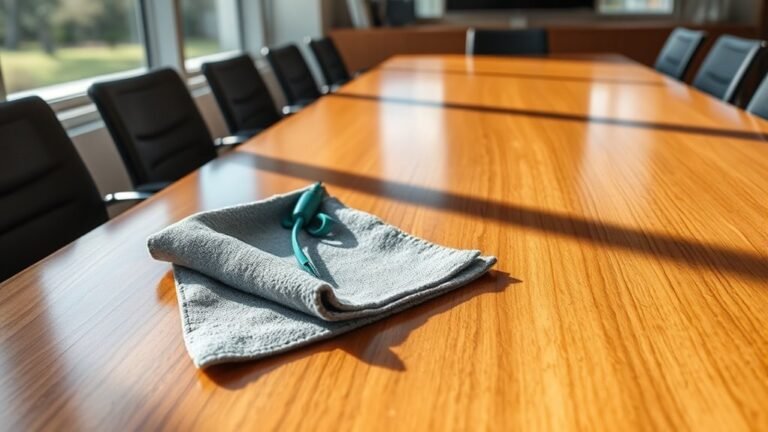Cleaning and Organizing a Small Business Office
To clean and organize your small business office, start by evaluating your space and decluttering unnecessary items to boost focus and efficiency. Choose eco-friendly, multipurpose cleaning supplies and set a regular cleaning schedule to maintain order. Organize desks with ergonomic setups and use smart storage solutions for small areas. Keep common spaces tidy and engage your team with incentives to foster responsibility. Implementing these habits creates a productive environment—there’s more to learn about fine-tuning your office for success.
Assessing Your Office Space and Needs

Before you plunge into cleaning, take a close look at your office space to understand its unique needs. You’ll want to review your office layout carefully, noting how furniture and equipment are arranged. This helps you identify areas where space utilization can improve, making your environment feel more open and freeing. Consider which zones are cluttered or underused, and think about how a more efficient layout could boost your productivity and comfort. By evaluating your office space with intention, you’re setting the stage for a cleaning routine that supports your goal of working freely and effectively. This thoughtful approach guarantees that every inch of your office serves a purpose, giving you the freedom to focus on what truly matters.
Decluttering to Maximize Efficiency
To boost your office efficiency, start by identifying items you don’t really need and removing them. Next, create clear storage zones so everything has its place. This way, you’ll keep your workspace organized and easy to navigate.
Identify Unnecessary Items
One simple way to boost your office’s efficiency is by identifying and removing unnecessary items. Start by scanning your workspace for unwanted materials like old papers, broken office supplies, or outdated promotional items that just take up space. These clutter your environment and stifle your freedom to create and focus. Next, look at your equipment—do you have redundant equipment that rarely gets used? Keeping duplicate printers or extra monitors might seem convenient but often just clogs your workspace and budget. Clearing out these distractions helps free your mind and your office, letting you work smarter, not harder. By consciously choosing what stays and what goes, you reclaim control over your environment, making it a place where productivity and creativity flow effortlessly.
Establish Clear Storage Zones
Creating designated storage zones is essential for keeping your office organized and efficient. By setting clear areas for different supplies, documents, and equipment, you free yourself from constant searching and clutter. Use storage bins to group similar items together, making everything easy to find and put away. Incorporate labeling systems on these bins and shelves to instantly identify contents without opening each container. This simple step saves time and mental energy, giving you more freedom to focus on your work. Tailor your storage zones to fit your workflow—whether it’s a zone for daily-use items, archived files, or office supplies. Clear storage zones transform chaos into order, letting you reclaim control over your space and your day.
Choosing the Right Cleaning Supplies

Selecting the right cleaning supplies can make a significant difference in maintaining your small business office efficiently. You want products that are effective but also align with your values, especially if you’re leaning toward eco friendly options. These not only reduce harmful chemicals but also create a healthier workspace for you and your team. At the same time, budget considerations are important—you don’t need to overspend to keep things spotless. Look for versatile, multipurpose cleaners that cut down on costs and clutter. Also, consider refillable containers or bulk purchases to save money and reduce waste. By choosing supplies thoughtfully, you’ll enjoy a cleaner office without sacrificing freedom or your bottom line. This balance helps you run your business smoothly and sustainably.
Setting a Regular Cleaning Schedule
Having a consistent cleaning schedule can make all the difference in keeping your office neat and organized. By setting weekly tasks and sticking to a cleaning checklist, you free yourself from chaotic clutter and last-minute scrambles. It’s about creating a rhythm that fits your work style, giving you more freedom to focus on what matters most.
Here’s a simple weekly cleaning checklist to get you started:
| Day | Task |
|---|---|
| Monday | Dust surfaces |
| Wednesday | Vacuum and mop floors |
| Friday | Empty trash and sanitize |
| Sunday | Review and restock supplies |
This routine keeps your space fresh without eating into your time, so you can enjoy a clean office and the freedom to work your way.
Organizing Desks and Workstations

Although it might seem small, keeping desks and workstations organized can boost your productivity and reduce stress. Start by optimizing desk ergonomics—adjust your chair, monitor, and keyboard to fit your natural posture. This not only prevents discomfort but also helps you focus longer without fatigue. Next, embrace workstation personalization to make your space truly yours. Add a few meaningful items that inspire you, like photos or a small plant, but keep clutter minimal. Use trays or organizers to keep essentials within reach but neatly stored. By balancing function with personal touches, you create an environment that supports freedom in your workday while maintaining order. This thoughtful setup helps you move through tasks smoothly, freeing your mind for creativity and efficiency.
Managing Paperwork and Digital Files
When you manage paperwork and digital files effectively, you’ll save time and reduce stress. Start by sorting your paperwork into clear categories—keep only what’s necessary and shred or recycle the rest. Use labeled folders or binders to keep everything accessible and neat. For digital organization, create a consistent folder structure on your computer or cloud storage. Name files clearly and back up important documents regularly to avoid loss. Using digital tools like scanning apps or document management software can streamline your paperwork management, minimizing clutter. By setting up simple routines for both physical and digital files, you’ll free yourself from chaos and focus on what truly matters—running your business with confidence and ease. This smart approach gives you the freedom to work smarter, not harder.
Creating Storage Solutions for Small Spaces
When space is tight, you can make a big difference by maximizing vertical storage with shelves and wall-mounted organizers. Choosing multi-functional furniture, like desks with built-in drawers or storage ottomans, helps keep your office tidy without crowding the room. These smart solutions let you stay organized and efficient in even the smallest spaces.
Maximizing Vertical Space
Vertical space is often overlooked but can be a game-changer in small business offices. When you tap into wall organization, you reveal a whole new dimension of freedom from clutter. Installing smart shelving systems lets you store files, supplies, and decor without eating up precious floor area. You don’t need bulky furniture crowding the room; instead, your walls become functional storage hubs. Use adjustable shelves to customize your setup as your needs evolve, keeping everything accessible yet out of the way. Hooks, pegboards, and floating shelves also help keep essentials organized vertically. By maximizing vertical space, you free up your office to feel open and inviting, making your workday smoother and more inspiring. Embrace your walls—they’re the key to a clutter-free, efficient office.
Multi-Functional Furniture Ideas
Three key pieces of multi-functional furniture can transform your small office by combining storage and workspace without crowding the room. Start with convertible desks that shift from compact workstations to full work surfaces, letting you adapt your space freely. Add modular shelving with integrated storage and hidden compartments to keep essentials organized and out of sight. Foldable tables offer extra workspace when needed and tuck away easily, maximizing room. Incorporate ergonomic seating that supports comfort without bulk. Multi-purpose carts provide mobility and versatile storage, while stylish organizers keep supplies tidy and accessible. These space saving designs give you the freedom to work efficiently and maintain a clean, open office environment. Embracing multi-functional furniture means you’re not sacrificing style or comfort for practicality.
Maintaining Common Areas and Break Rooms
Although common areas and break rooms may seem less critical than workspaces, keeping them clean is essential for a healthy and inviting office environment. You want to promote break room etiquette that encourages everyone to clean up after themselves and respect shared spaces. Regular common area maintenance prevents clutter and keeps everything running smoothly without micromanagement.
Here’s a simple routine you can follow:
| Task | Frequency | Responsibility |
|---|---|---|
| Wipe surfaces | Daily | All employees |
| Restock supplies | Weekly | Office manager |
| Deep clean fridge | Monthly | Cleaning service |
Stick to this, and your break rooms will stay welcoming and free of distractions, giving you the freedom to focus on what matters most.
Encouraging Employee Participation in Cleanliness
Keeping common areas clean is a great start, but you’ll get the best results when everyone pitches in. To foster a sense of freedom and ownership, try introducing office cleanliness incentives that reward your team for maintaining tidy workspaces. Simple perks like casual dress days or gift cards can motivate without feeling restrictive. You can also spice things up with team cleaning challenges—making the process fun and collaborative rather than a chore. When employees feel involved and appreciated, they’re more likely to take responsibility for their environment. By encouraging participation through positive reinforcement and friendly competition, you create a culture where cleanliness doesn’t feel imposed but chosen. This approach keeps your office fresh and your team engaged, all while respecting their independence.
Implementing Long-Term Organization Strategies
When you want your office to stay orderly over time, it’s essential to put long-term organization strategies in place. Start by setting clear long term goals that align with your vision of a clutter-free, efficient workspace. Integrate sustainable practices like digitizing documents to reduce paper waste and using reusable storage solutions. Create systems that everyone can easily follow, so maintaining order doesn’t become a chore. Regularly review and adjust these strategies to fit your evolving needs, ensuring they remain effective without restricting your freedom or creativity. By focusing on sustainable, practical habits, you empower yourself and your team to keep the office organized effortlessly. This way, your workspace supports productivity and peace of mind, freeing you to focus on what truly matters—growing your business.
Frequently Asked Questions
How Often Should I Deep Clean Office Carpets and Upholstery?
Imagine a cozy café where the owner deep cleans the carpets and upholstery every six months to keep the space inviting. For you, regular carpet maintenance and upholstery care should happen at least twice a year. If your office sees heavy foot traffic, quarterly cleanings might be better. This routine prevents dirt buildup and extends the life of your furnishings, giving you the freedom to focus on what matters without worrying about grime.
What Are the Best Eco-Friendly Cleaning Products for Offices?
When you want to keep things fresh and eco-friendly, green cleaning products are your best bet. Look for sustainable supplies like biodegradable sprays, reusable microfiber cloths, and plant-based detergents. These choices not only protect the environment but also give you the freedom to maintain a healthy space without harsh chemicals. You’ll feel good knowing you’re doing your part while keeping your surroundings clean and vibrant.
How Can I Reduce Allergens in a Small Office Environment?
You might think allergens are just part of indoor life, but you can actually take control. Using air purifiers with HEPA filters can dramatically cut airborne allergens, giving you fresher, cleaner air. Don’t underestimate dust management either—regularly dusting and vacuuming with a HEPA-filter vacuum traps irritants before they settle. By tackling these two areas, you’ll create a freer, healthier space where allergens don’t hold you back.
What Are Effective Ways to Disinfect Electronics Without Damage?
When disinfecting keyboards, you’ll want to use a soft, lint-free cloth lightly dampened with isopropyl alcohol—never spray directly. For sanitizing screens, choose screen-safe wipes or a microfiber cloth with a bit of distilled water mixed with alcohol. This way, you protect your devices while keeping germs at bay. You don’t have to be overly cautious; just avoid harsh chemicals or excessive moisture, and your electronics will stay safe and clean.
How Do I Handle Confidential Documents During Cleaning?
Imagine your confidential documents as treasures locked inside a sturdy chest. To keep them safe during cleaning, don’t just toss them around. Use document shredding for anything you no longer need, turning secrets into harmless confetti. For what you keep, choose secure storage—like a locked drawer or safe—so your freedom from worry stays intact. This way, your sensitive info stays protected, letting you focus on what truly matters.






